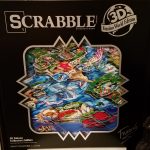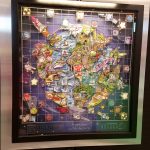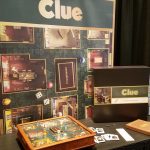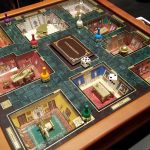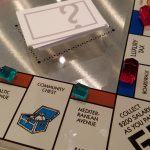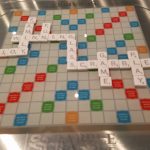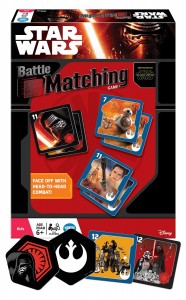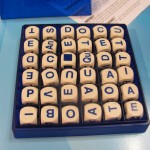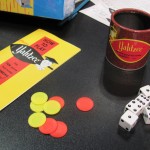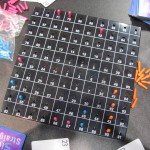 The folks at WS Game Company were busy with buyers from store chains large and small at Toy Fair this year and it’s no wonder. The company makes high-end versions of classic boardgames. These are games that put presentation above all else, whether it’s something as inexpensive as their $25-$30 Nostalgia Tin line or their top-of-the-line Franklin Mint Collector’s Editions of Scrabble and Monopoly (both available now, $500).
The folks at WS Game Company were busy with buyers from store chains large and small at Toy Fair this year and it’s no wonder. The company makes high-end versions of classic boardgames. These are games that put presentation above all else, whether it’s something as inexpensive as their $25-$30 Nostalgia Tin line or their top-of-the-line Franklin Mint Collector’s Editions of Scrabble and Monopoly (both available now, $500).
Yesterday, we showcased the Monopoly Miami Edition with art from Romero Britto. Next to that game was a Scrabble set, featuring the artwork of Charles Fazzino. This set, the Scrabble 3D World Edition (available now, $500), features layered elements creating a 3D piece of artwork below the playing surface. The glass letter tiles are larger than your standard Scrabble set. Like the Monopoly set, this art edition of Scrabble is limited to 2000 copies.
- Scrabble 3D World Edition
- Hey! That is not a legal play!
- Closer…
- Or maybe you want to frame it?
Perhaps you want a simple “luxury” edition of Scrabble, Monopoly, or Clue? On April 15th, they will be available for $250 apiece. Both Monopoly and Scrabble come with gold foil-stamped play elements (the outer path, houses and hotels, and tokens in Monopoly, the raised grid, sand timer, and tile holders in Scrabble). Monopoly has the central area sunken for dice rolling on a faux-leather surface while Scrabble has faux-ivory letter tiles. Of this line, the one that really caught my eye was the Clue edition with sunken, three-dimensional mansion rooms beneath the glass surface. The murder weapons and the bases of the suspects are gold foil-stamped as well.
- Clue!
- Each room as a showpiece element inside.
- Scrabble!
- Now these all look like legal plays.
But then there’s the glass versions of Monopoly and Scrabble that will be available in August at a price point yet to be determined. The game art on these is printed on tempered glass. The Scrabble set’s board rotates and the tiles have non-slip coatings to keep them in place. The Monopoly board has more glass elements: not only is the board glass, but the houses and hotels are as well. These are sharp-looking games, even though they come with rounded corners.
- One of the few times the reflections of the lights in the convention center helped.
- The other time.
The Monopoly Transformers Edition appears to be a piece of artwork featuring Generation 1 Transformers, but the frames swing open to reveal the themed outer track. Instead of properties, you’re purchasing transforming robots that… you place houses and hotels on to collect rent? Okay. Unlike most licensed Monopoly games, there is no Go! space — here, it’s ROLL OUT! (and collect $200). To be released in August, the price hasn’t been determined yet, but you can mortgage Megatron for $160 to help save up.
WS Game Company’s line of vintage bookshelf games did amazingly well for them last year. At a $40 price point for Monopoly, Scrabble, and Clue, these games in book-like boxes is inspired by vintage graphics. Coming out later this year (August, again) at a price point that’s unknown (but probably $40 like the currently-available batch) are Yathzee’s 1956 edition, The Game of Life’s 1960 edition, Trivial Pursuit’s 1981 Genius edition, and Scattergories’ 1988 edition.
Twister joins the Collectible Tin line, alongside Candy Land, Chutes & Ladders, Scrabble, Monopoly, Clue, Sorry!, and Mystery Date. Twister, available in August as well, will retail for $30, like the majority of the line. Candy Land and Chutes & Ladders are the only outliers at the $25 level.
- Comments Off on Toy Fair 2017—WS Game Company
More Star Wars The Force Awakens Games
10 Sep
Posted by David Miller as Electronic Games, Modern Board Games
I already wrote about Star Wars The Force Awakens games from Hasbro, Spin Master, and Topps but, as you’ll see below, there are still more.
Some of these may be exclusive to certain retailers. Also, some saw publication under a Star Wars theme previously but all have now at least been updated with the latest characters, graphic design, and images.
The Star Wars Death Star Perplexus 3-D maze has lights and sounds and… well, let’s be fair, was already shaped like a Death Star. Spin Master is distributing it to major retail outlets, Patch Products to specialty stores.
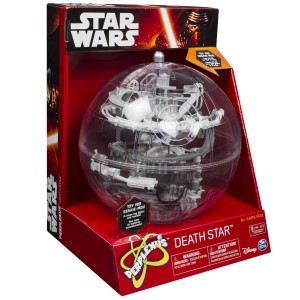
Spin Master is also doing a Star Wars Death Star Boom Boom Balloon. It seems like such an obvious fit, yet don’t the good guys want the Death Star to explode?
Uncle Milton’s selling a Star Wars Jedi Holocron. It’s an electronic thingamabob that can guess what you’re thinking (providing it’s related to Star Wars) within 20 questions.
From Wonder Forge, there’s a Star Wars The Force Awakens Battle Matching Game, which supposedly adds a twist to basic matching games but what that is I don’t know.
Also from Wonder Forge is Star Wars The Force Awakens 6-in-1, which includes the Battle Matching Game, as well as Star Wars versions of Dominoes, Bingo, and other standards.
Exclusive for Target, Wonder Forge has made the Star Wars Star Destroyer Strike Game. This one has the Finalizer at the center shooting actual lasers.
Toys “R” Us has two more Star Wars games from Hasbro: Star Wars Guess Who? and Star Wars Sorry. The latter imagines droids darting around the Millennium Falcon attempting to effect repairs without getting in each other’s way.
![]()
 Stop It! is Winning Moves’ version of a card game where players play their cards in numeric order within each suit and the first to get rid of all their cards wins. The twist in Stop It! is that all 50 cards are dealt out at the start—which on its own would make the game pointless—but so are a number of “Stop It!” cards equal to one less than the number of players. Everyone knows that someone has the number 10 in each suit, so any one at any time can grab a Stop It! card to end play in one sequence and then start a new one.
Stop It! is Winning Moves’ version of a card game where players play their cards in numeric order within each suit and the first to get rid of all their cards wins. The twist in Stop It! is that all 50 cards are dealt out at the start—which on its own would make the game pointless—but so are a number of “Stop It!” cards equal to one less than the number of players. Everyone knows that someone has the number 10 in each suit, so any one at any time can grab a Stop It! card to end play in one sequence and then start a new one.
Winning Moves continues to upsize Bogle with Super Big Boggle and a 6 x 6 grid of letter cubes. In this version the timer has been increased to 4 minutes, double-letter cubes have letter pairs on all sides, a blocking cube interrupts a row and column, and words must be a minimum of four letters long.
And this year’s crop of classic reprints from Winning Moves includes Yahtzee (in original packaging with an aluminum dice cup), Sorry (the 1930s era board with Point Sorry variant “for adult play”), and 5ive Straight. The last is a deceptively simple five-in-a-row game with an unusual board. Of course, the goal is to get five pegs in a straight line. The board is a 10 x 10 grid with spaces numbered 0 to 99 in a circuitous pattern. And the game includes a deck of cards numbered 0 to 99. Players start with four cards and each turn can either draw a new card or play a card to place a peg in a hole numbered that or higher. So it seems the lower-numbered cards provide more flexibility, while it’s good to target higher-numbered spaces for completing a line.
- Comments Off on Toy Fair 2013—Winning Moves
Trending
- Massdrop.com
- Oh the Irony—Illuminati Card Game Continues to Inspire Conspiracy Theorists
- Footprints, an Educational Ecology Game
- USPS Adds Board Game Flat Rate Box
- Home
- Baila, the Estonian Drinking Card Game
- Crystal Caste Wins Dice Patent Suit Against Hasbro
- Mirror Game, Red and Blue
- Hasbro and Mattel Merger?
- Are Board Games Dangerous?
Archives
Most Popular Articles
- Oh the Irony—Illuminati Card Game Continues to Inspire Conspiracy Theorists
- The 20 Most Valuable Vintage Board Games
- The Truth About Dominoes On Sunday in Alabama
- Sequence Game, and Variants
- USPS Adds Board Game Flat Rate Box
- Baila, the Estonian Drinking Card Game
- The 13 Most Popular Dice Games
- Are Board Games Dangerous?
- Guess Who? The Naked Version
- What Happened to the Jewel Royale Chess Set?
Recent Posts
- Toy Fair 2019—Breaking Games
- Talisman Kingdom Hearts Edition
- Toy Fair 2019—Winning Moves
- Toy Fair 2019—Games Workshop
- Toy Fair 2019—Star Wars Lightsaber Academy
- Toy Fair 2019—Stranger Things Games
- Toy Fair 2019—HABA
- Licensing Roundup
- Game Bandit
- 2018 A Difficult Year For Hasbro But Not For D&D Or MtG
Recent Comments
- on Toy Fair 2019—Winning Moves
- on Game Bandit
- on Second Look—Dungeons & Dragons Waterdeep Dragon Heist
- on Crowdfunding Highlights
- on Beyblade SlingShock
- on Game Bandit
- on Game Bandit
- on Watch This Game!, the Board Game Review Board Game
- on Second Look—Vampire: The Masquerade 5th Edition
- on Palladium Books Loses Robotech IP License, Cancels Five-Year-Overdue Robotech RPG Tactics Kickstarter

